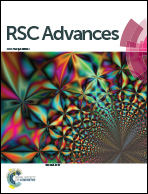Relationship investigation of molecular structure–binding affinity of antibiotics to bovine serum albumin using flow injection chemiluminescence analysis and molecular docking†
Abstract
Luminescently probed by luminol, the interaction behaviors of bovine serum albumin (BSA) with different antibiotics (macrolides, tetracyclines and sulfonamides) at picomolar levels were investigated using flow injection chemiluminescence (FI-CL) analysis. It was found that BSA and antibiotics formed complexes with the binding ratio of 1 : 1, with the binding constants K within the range of 103 to 105 L mol−1 generally following the order of macrolides < tetracyclines < sulfonamides. Results showed that the ester groups of –OOCC3H7 or –OOC(CH2)2COOC2H5 in macrolides led to increased K by factors of 3.1–42.8 times, –OH or –Cl in tetracyclines increased K by 1.1–1.3 times, and the additional –C(![[double bond, length as m-dash]](https://www.rsc.org/images/entities/char_e001.gif) NH)NH2 in sulfonamides increased K about 1.3 times. The thermodynamic parameters demonstrated that the BSA–antibiotic binding process should be spontaneous mainly through hydrophobic interaction for macrolides, hydrogen bonding and van der Waals force for tetracyclines, and electrostatic interaction for sulfonamides. The further antibiotics to BSA molecular docking study revealed that the pocket at subdommain IIA of BSA should be the principle binding site for antibiotics, showing that the interaction parameters including K and ΔG agreed well with the results from the proposed FI-CL analysis. The interesting phenomenon that the log K had good linear correlation to molecular volume MV, molar refractivity MR, polarizability POL and partition coefficient log P of antibiotics was also observed.
NH)NH2 in sulfonamides increased K about 1.3 times. The thermodynamic parameters demonstrated that the BSA–antibiotic binding process should be spontaneous mainly through hydrophobic interaction for macrolides, hydrogen bonding and van der Waals force for tetracyclines, and electrostatic interaction for sulfonamides. The further antibiotics to BSA molecular docking study revealed that the pocket at subdommain IIA of BSA should be the principle binding site for antibiotics, showing that the interaction parameters including K and ΔG agreed well with the results from the proposed FI-CL analysis. The interesting phenomenon that the log K had good linear correlation to molecular volume MV, molar refractivity MR, polarizability POL and partition coefficient log P of antibiotics was also observed.


 Please wait while we load your content...
Please wait while we load your content...